
A | B | C | D | E | F | G | H | CH | I | J | K | L | M | N | O | P | Q | R | S | T | U | V | W | X | Y | Z | 0 | 1 | 2 | 3 | 4 | 5 | 6 | 7 | 8 | 9
Sikh Empire Sarkār-i-Khālsa Khālasā Rāj | |||||||||||||||||||||
|---|---|---|---|---|---|---|---|---|---|---|---|---|---|---|---|---|---|---|---|---|---|
| 1799–1849 | |||||||||||||||||||||
| Motto: ਅਕਾਲ ਸਹਾਇ Akāl Sahāi "With God's Grace" | |||||||||||||||||||||
| Anthem: ਦੇਗ ਤੇਗ ਫ਼ਤਿਹ Dēg Tēg Fateh "Victory to Charity and Arms" | |||||||||||||||||||||
 The Sikh Empire at its greatest extent c. 1839, under Ranjit Singh | |||||||||||||||||||||
| Status | Empire | ||||||||||||||||||||
| Capital |
| ||||||||||||||||||||
| Common languages | |||||||||||||||||||||
| Religion | |||||||||||||||||||||
| Government | Federal monarchy | ||||||||||||||||||||
| Maharaja | |||||||||||||||||||||
• 1801–1839 | Ranjit Singh (first) | ||||||||||||||||||||
• 1843–1849 | Duleep Singh (last) | ||||||||||||||||||||
| Regent | |||||||||||||||||||||
• 1840–1841 | Chand Kaur | ||||||||||||||||||||
• 1843–1846 | Jind Kaur | ||||||||||||||||||||
| Vizier | |||||||||||||||||||||
• 1799–1818 | Khushal Singh Jamadar (first) | ||||||||||||||||||||
• 1846 | Gulab Singh (last) | ||||||||||||||||||||
| Historical era | Early modern period | ||||||||||||||||||||
• Capture of Lahore by Ranjit Singh | 7 July 1799 | ||||||||||||||||||||
• End of Second Anglo-Sikh War | 29 March 1849 | ||||||||||||||||||||
| Area | |||||||||||||||||||||
| 1839[5] | 520,000 km2 (200,000 sq mi) | ||||||||||||||||||||
| Population | |||||||||||||||||||||
• 1800s | 12,000,000[6] | ||||||||||||||||||||
| Currency | Nanak Shahi Sikke | ||||||||||||||||||||
| |||||||||||||||||||||
| Today part of | |||||||||||||||||||||
| History of India |
|---|
 |
| Timeline |
The Sikh Empire was a regional power based in the Punjab region of the Indian subcontinent.[7] It existed from 1799, when Maharaja Ranjit Singh captured Lahore, to 1849, when it was defeated and conquered by the British East India Company in the Second Anglo-Sikh War. It was forged on the foundations of the Khalsa from a collection of autonomous misls.[1][8] At its peak in the 19th century, the empire extended from Gilgit and Tibet in the north to the deserts of Sindh in the south and from the Khyber Pass in the west to the Sutlej in the east as far as Oudh.[9][10] It was divided into four provinces: Lahore, which became the Sikh capital; Multan; Peshawar; and Kashmir from 1799 to 1849. Religiously diverse, with an estimated population of 4.5 million in 1831 (making it the 19th most populous country at the time),[11] it was the last major region of the Indian subcontinent to be annexed by the British Empire.
The formation of the empire began with the capture of Lahore from its Durrani ruler, Zaman Shah Durrani. Ranjit Singh was proclaimed as Maharaja of the Punjab on 12 April 1801 (to coincide with Vaisakhi), creating a unified political state. Sahib Singh Bedi, a descendant of Guru Nanak, conducted the coronation.[12] The formation of the empire was followed by the progressive expulsion of Afghans from Punjab by capitalizing off Afghan decline in the Afghan-Sikh Wars, and the unification of the separate Sikh misls. Ranjit Singh rose to power in a very short period, from a leader of a single misl to finally becoming the Maharaja of Punjab. He began to modernise his army, using the latest training as well as weapons and artillery. After the death of Maharaja Ranjit Singh, the empire was weakened by the British East India Company stoking internal divisions and political mismanagement. Finally, in 1849, the state was dissolved after the defeat in the Second Anglo-Sikh War.
Terminology
The empire is also referred to as the Lahore State, such as in contemporary British maps.[13][14] The term Lahore Darbar refers to the Sikh court at Lahore of the empire's ruling government.[note 2][15] However, the term "Lahore Darbar" only gained currency around the time of Ranjit Singh's death, with it not being found in British sources until then.[15] The empire's own Persian chronicles refers to its ruling government as the Sarkar Khalsaji.[15]
History
Background
The foundation of the Sikh Empire can be traced to as early as 1707, the year of Aurangzeb's death and the start of the downfall of the Mughal Empire. With the Mughals significantly weakened, the Sikh army, known as the Dal Khalsa, a rearrangement of the Khalsa inaugurated by Guru Gobind Singh, led expeditions against them and the Afghans in the west. This led to a growth of the army which split into different confederacies or semi-independent misls. Each of these component armies controlled different areas and cities. However, in the period from 1762 to 1799, Sikh commanders of the misls appeared to be coming into their own as independent.
Mughal rule of Punjab
Sikhism began during the conquest of North India by Babur, the founder of the Mughal Empire. His grandson, Akbar, supported religious freedom and after visiting the langar of Guru Amar Das got a favourable impression of Sikhism. As a result of his visit, he donated land to the langar and the Mughals did not have any conflict with Sikh gurus until his death in 1605.[16]
His successor Jahangir, saw the Sikhs as a political threat. He ordered Guru Arjan, who had been arrested for supporting the rebellious Khusrau Mirza,[17] to change the passage about Islam in the Adi Granth. When the Guru refused, Jahangir ordered him to be put to death by torture.[18] Guru Arjan's martyrdom led to the sixth Guru, Guru Hargobind, declaring Sikh sovereignty in the creation of the Akal Takht and the establishment of a fort to defend Amritsar.[19]
Jahangir attempted to assert authority over the Sikhs by jailing Guru Hargobind at Gwalior Fort, but released him after a number of years when he no longer felt threatened. The Sikh community did not have any further issues with the Mughal Empire until the death of Jahangir in 1627. The succeeding son of Jahangir, Shah Jahan, took offence at Guru Hargobind's "sovereignty" and after a series of assaults on Amritsar forced the Sikhs to retreat to the Sivalik Hills.[19]
The next guru, Guru Har Rai, maintained the guruship in these hills by defeating local attempts to seize Sikh land and playing a neutral role in the power struggle between two of the sons of Shah Jahan, Aurangzeb and Dara Shikoh, for control of the Mughal Empire. The ninth Guru, Guru Tegh Bahadur, moved the Sikh community to Anandpur and travelled extensively to visit and preach in defiance of Aurangzeb, who attempted to install Ram Rai as new guru. Guru Tegh Bahadur aided Kashmiri Pandits in avoiding conversion to Islam and was arrested by Aurangzeb. When offered a choice between conversion to Islam and death, he chose to die rather than compromise his principles and was executed.[20]
Formation of the Khalsa
Guru Gobind Singh assumed the guruship in 1675 and to avoid battles with Sivalik Hill rajas moved the guruship to Paunta. There he built a large fort to protect the city and garrisoned an army to protect it. The growing power of the Sikh community alarmed the Sivalik Hill rajas, who attempted to attack the city, but Guru Gobind Singh's forces routed them at the Battle of Bhangani. He moved on to Anandpur and established the Khalsa, a collective army of baptised Sikhs, on 30 March 1699.[21]
The establishment of the Khalsa united the Sikh community against various Mughal-backed claimants to the guruship.[22] In 1701, a combined army of the Sivalik Hill rajas and the Mughals under Wazir Khan attacked Anandpur. The Khalsa retreated but regrouped to defeat the Mughals at the Battle of Muktsar. In 1707, Guru Gobind Singh accepted an invitation by Aurangzeb's successor Bahadur Shah I to meet him. The meeting took place at Agra on 23 July 1707.[21]
Banda Singh Bahadur
In August 1708, Guru Gobind Singh visited Nanded. There he met a Bairāgī recluse, Madho Das, who converted to Sikhism, rechristened as Banda Singh Bahadur.[21][23] A short time before his death, Guru Gobind Singh ordered him to reconquer Punjab region and gave him a letter that commanded all Sikhs to join him. After two years of gaining supporters, Banda Singh Bahadur initiated an agrarian uprising by breaking up the large estates of Zamindar families and distributing the land to the poor peasants who farmed the land.[24]
Banda Singh Bahadur started his rebellion with the defeat of Mughal armies at Samana and Sadhaura and the rebellion culminated in the defeat of Sirhind. During the rebellion, Banda Singh Bahadur made a point of destroying the cities in which Mughals had been cruel to the supporters of Guru Gobind Singh. He executed Wazir Khan in revenge for the deaths of Guru Gobind Singh's sons and Pir Budhu Shah after the Sikh victory at Sirhind.[25]
He ruled the territory between the Sutlej river and the Yamuna river, established a capital in the Himalayas at Lohgarh and struck coinage in the names of Guru Nanak and Guru Gobind Singh.[24] In 1716, his army was defeated by the Mughals after he attempted to defend his fort at Gurdas Nangal. He was captured along with 700 of his men and sent to Delhi, where they were all tortured and executed after refusing to convert to Islam.[26]
Dal Khalsa period
Sikh Confederacy
The period from 1716 to 1799 was a highly turbulent time politically and militarily in the Punjab region. This was caused by the overall decline of the Mughal empire[27] that left a power vacuum in the region that was eventually filled by the Sikhs of the Dal Khalsa, meaning "Khalsa army" or "Khalsa party". In the late 18th century, after defeating several invasions by the Afghan rulers of the Durrani Empire and their allies,[28] remnants of the Mughals and their administrators, the Mughal-allied Hindu hill-rajas of the Sivalik Hills,[29][30] and hostile local Muslims siding with other Muslim forces.[28] The Sikhs of the Dal Khalsa eventually formed their own independent Sikh administrative regions, Misls, derived from a Perso-Arabic term meaning 'similar', headed by Misldars. These Misls were united in large part by Maharaja Ranjit Singh.
Intra-Misl Wars
This section needs additional citations for verification. (November 2022) |
After the reign of Jassa Singh Ramgarhia, the Sikh Misls became divided and fought each other. A sort of 'Cold War' broke out with the Bhangi, Nakkai, Dalelwala and Ramgharia Misls verses Sukerchakia, Ahluwalia, Karor Singhia and Kaniyeha. The Shaheedan, Nishania and Singhpuria also allied but did not engage in warfare with the others and continued the Dal Khalsa.
The Phulkian Misl was excommunicated from the confederacy. Rani Sada Kaur of the Kanhaiya Misl rose in the vacuum and destroyed the power of the Bhangis. She later gave her throne to Maharaja Ranjit Singh.
Empire
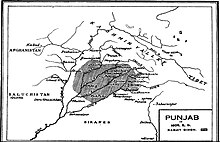
The formal start of the Sikh Empire began with the unification of the Misls by 1801, creating a unified political state. All the Misl leaders, who were affiliated with the army, were the nobility with usually long and prestigious family backgrounds in Sikh history.[1]
The main geographical footprint of the empire was from the Punjab region to Khyber Pass in the west, to Kashmir in the north, Sindh in the south, and Tibet in the east.[31]
In 1799, Ranjit Singh moved the capital to Lahore from Gujranwala, where it had been established in 1763 by his grandfather, Charat Singh.[32]
Ranjit Singh annexed the Sial State, a local Muslim-ruled chieftaincy, after invading Jhang in 1807.[33] The basis for this annexation was that the local ruler of Jhang, Ahmad Khan Sial, was conspiring with Nawab Muzaffar Khan of Multan and had signed a secret treaty with the latter.[33]

Hari Singh Nalwa was Commander-in-Chief of the Sikh Khalsa Army from 1825 to 1837.[34] He is known for his role in the conquests of Kasur, Sialkot, Multan, Kashmir, Attock and Peshawar. Nalwa led the Sikh army in freeing Shah Shuja from Kashmir and secured the Koh-i-Nor diamond for Maharaja Ranjit Singh. He served as governor of Kashmir and Hazara and established a mint on behalf of the Sikh empire to facilitate revenue collection. His frontier policy of holding the Khyber Pass was later used by the British Raj. Nalwa was responsible for expanding the frontier of Sikh empire to the Indus River. At the time of his death, the western boundary of the Sikh Empire was the Khyber Pass.
The Namgyal dynasty of Ladakh paid regular annual tribute to the Sikh Empire starting 1819 until 1834.[35] The tribute was paid to the local Sikh governors of Kashmir.[35] The Namgyal kingdom would later be conquered by the Dogras, under the leadership of Zorawar Singh.[36]
The domain of the Maqpon kingdom of Baltistan, based in Skardu, under the rule of Ahmad Shah Maqpon, was conquered in 1839–40 and its local ruler was deposed.[36][37][38][39] The Dogras at this time were under the suzerainty of the Sikh Empire.[36]
During the Sino-Sikh War of 1841, the forces of the empire invaded the Tibetan Plateau, which was then under the control of the Qing dynasty.[40] However, this control was short-lived and the military of the empire was forced to retreat to Ladakh due to a counterattack by the Chinese and Tibetans.[40]
Cis-Sutlej states
The Cis-Sutlej states were a group of Sikh[41] states in the Punjab region lying between the Sutlej River to the north, the Himalayas to the east, the Yamuna River and Delhi district to the south, and Sirsa District to the west. These states fell under the suzerainty of the Maratha Empire after 1785 before the Second Anglo-Maratha War of 1803–1805, after which the Marathas lost control of the territory to the British East India Company. The Cis-Sutlej states included Kalsia, Kaithal, Patiala State, Nabha State, Jind State, Thanesar, Maler Kotla, Ludhiana, Kapurthala State, Ambala, Ferozpur and Faridkot State, among others.[42] The Sikh Empire of Ranjit Singh occupied Faridkot State in 1807.[43] However, control was restored to Gulab Singh of Faridkot in 1809 due to the signing of a treaty between the Lahore Darbar and the British East India Company.[43]
While these Sikh states had been set up by the Dal Khalsa, they did not become part of the Sikh Empire. There was a mutual ban on warfare following the treaty of Amritsar in 1809 (in which the empire forfeited the claim to the Cis-Sutlej States, and the British were not to interfere north of the Sutlej or in the empire's existing territory south of the Sutlej),[44] following attempts by Ranjit Singh to wrest control of these states from the British between 1806 and 1809[45][46]
The Sikh crossing of the Sutlej, following British militarization of the border with Punjab (from 2,500 men and six guns in 1838 to 17,612 men and 66 guns in 1844, and 40,523 men and 94 guns in 1845), and plans on using the newly conquered territory of Sindh as a springboard to advance on the Sikh-held region of Multan,[47] eventually resulted in conflict with the British.
Decline
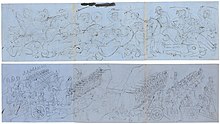
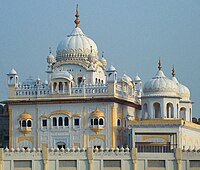
After Ranjit Singh's death in 1839, the empire was severely weakened by internal divisions and political mismanagement. This opportunity was used by the British East India Company to launch the First Anglo-Sikh War.
The Battle of Ferozeshah in 1845 marked many turning points, the British encountered the Punjab Army, opening with a gun-duel in which the Sikhs "had the better of the British artillery". As the British made advances, Europeans in their army were specially targeted, as the Sikhs believed if the army "became demoralized, the backbone of the enemy's position would be broken".[48] The fighting continued throughout the night. The British position "grew graver as the night wore on", and "suffered terrible casualties with every single member of the Governor General's staff either killed or wounded".[49] Nevertheless, the British army took and held Ferozeshah. British General Sir James Hope Grant recorded: "Truly the night was one of gloom and forbidding and perhaps never in the annals of warfare has a British Army on such a large scale been nearer to a defeat which would have involved annihilation."[49]
The reasons for the withdrawal of the Sikhs from Ferozeshah are contentious. Some believe that it was treachery of the non-Sikh high command of their own army which led to them marching away from a British force in a precarious and battered state. Others believe that a tactical withdrawal was the best policy.[citation needed]
The Sikh empire was finally dissolved at the end of the Second Anglo-Sikh War in 1849 into separate princely states and the British province of Punjab. Eventually, a Lieutenant Governorship was formed in Lahore as a direct representative of the British Crown.
Administration and state
Government
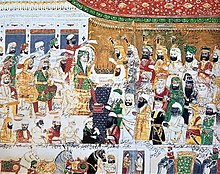
The empire's ruling court based out of Lahore is termed the Lahore Darbar.[15] The ruling court was diverse and under the ultimate command of the ruling maharaja, whom was the "drum of the Khalsa".[15] In-theory, the Sikh court was based on the Khalsa ideals propounded by Guru Gobind Singh yet the court was secular in-practice.[15] As an example of this secularism, members of the court came from various religious background, including Sikhs, Hindus, Muslims, and Christians.[15] Furthermore, the members also came from various ethnic, regional, and caste backgrounds, such as Dogras, Rajputs, Brahmins, Jats, and Europeans.[15] Whilst Ranjit Singh himself preferred to dress modestly, the Sikh court was filled with elaborately garbed and decorated members.[15] Only three individuals were permitted to be seated on chairs within the durbar, them namely being heir-apparent Kharak Singh, kanwar Sher Singh, and Raja Hira Singh.[15] Three sides of the hall of the durbar were covered with golden-pillars, with shawl carpets that were embroidered with golden and silver, and inset with precious stones, decorating the floor.[15] The maharaja was seated on a golden throne, with Ranjit Singh preferring to sit cross-legged on it.[15] The member of the court allowed to be seated behind the maharaja was Raja Dhian Singh.[15] The rest of the members of the court were seated as per their rank and status.[15] The colours of the Sikh court were yellow and green.[15] Thus, most of its members donned yellow-coloured dressings made from Kashmiri silk or woollens.[15] However, there existed no strict categorization scheme of the rankings of the constituent members of the Lahore Darbar, thus the rankings of its members was determined by the level of trust the maharaja held in them.[15] The court also granted awards upon its members, with most of these essentially being bestowed titles in the form of honourifics, however some members were granted jagirs (estate grant).[15] Laziness was heavily looked-down upon with the court, with the ruling maharaja often sending out the court's members on military or diplomatic missions.[15]
The business of the ruling government was carried out in Lahore, specifically the Musamman Burj located within the Lahore Fort.[15] A public court was held from morning until noon in the Diwan-i-Aam ("hall of audience"), with the court being attended by important members of the court, including princes, ministers, nobles, and civil and military officers.[15] Some matters discussed in the court include high-level civil and military appointments, reports from the provincial satraps and kardars.[15] When matters of the court were read-out, royal decrees made orally were transferred into writing for final approval.[15] Tributes and nazaranas were also exchanged or bestowed within the court.[15] Supplicants to the court were dismissed with khill'ats (robes) or monetary gifts.[15] When the maharaja was travelling, the court ceased to be static and was held at whatever location the ruler's retinue decided to hold-up at, often under a tree or whilst moving on horseback.[15] The ruler would dictate orders to provincial governors whilst inspecting their troops or even in the midst of battle.[15]
Noble members of the court, including relatives of the royal family, resided in palatial haveli structures and donned expensive clothing and accessories (such as jewelry).[15] The Sikh princes, and also Raja Dhian Singh, were permitted to hold their own miniature durbars (courts).[15]
Foreign affairs

Foreign visitors to the Sikh court were treated with respect and hospitality, with many contemporary accounts of foreign visitors to the court noting the good-treatment afforded to them by the state.[15] When a foreign visitor arrived, they would be greeted by a protocol officer, who would arrange for their temporary residence, which was based upon the status of the visitor.[15] The state government paid for the expenses regarding the visitor's entertainment.[15] There exists accounts of visitors being gifted by the state, with presents such as fruit, sweets, wines, and also money.[15] Full displays of the empire's regalia and military forces were displayed during important ceremonial functions, such as the marriages of important nobles or when receiving high-level foreign diplomatic dignatories.[15]
In order to keep tabs and updated on the happenings of surrounding regions, including remote parts of its territory and foreign countries, the Sikh court received reports from the waqa'nawis (news-writers) located in the empire's provinces (subas).[15] The reports were dispatched to the Lahore Darbar at regular intervals.[15] Furtheremore, the vakils (agents) of foreign countries were associated with the Sikh court on a reciprocal basis.[15] The Sikh court had news-writers located in Afghanistan and also had its own vakil emissaries in the Cis-Sutlej States and also in territory under the British East India Company's rule.[15] Other vakil emissaries of the Sikh court were sent to Rajputana, the Marathas, and Nepal on complimentary missions.[15]
Western/European officers from various backgrounds, including Britishers, Frenchmen, Germans, Italians, Spaniards, Americans, and Russians, also rose to high levels within the Sikh court in many instances.[15] However, the Sikh court was wary of the Westerners within the court, and kept them therefore under strict regulation.[15] These foreign Western members of the court were persuaded by the state to integrate themselves by marrying a local woman, settling down within the empire, and adopt the cultural customs of the locals, such as growing out a beard or wearing a turban.[15] The Western members of the court were also banned from publicly consuming beef or smoking.[15]
The Sikh Empire did enact a simple border policy where it did not allow uninvited foreigners into the state.[50] The purpose of this border policy was to dissuade potential foreign spies from entering the country.[50] An example of the policy in-action is the case of Captain Arnold Mathews, whom snuck into the Sikh Empire in circa 1808 to spy under the guise of being a tourist headed towards Kashmir but was intercepted and brought to Lahore.[50]
Holidays

The Sikh court observed the festivals of Vaisakhi, Dussehra, Basant, Holi, and Diwali.[15] Vaisakhi was considered an especially auspicious celebration within the Sikh court, with it giving and distributing gifts of money, gold, silver, cows, horses, elephants, gold-bangles, and food to Brahmins and the poor.[15] During Basant celebrations, the military troops of the empire were paraded donning yellow uniforms, with members of the Sikh court and nobiles also wearing yellow clothing on the day.[15] During Basant, the officials bore gifts for the sovereign ruler, with the ruler in-turn bestowing robe-of-honours to the officials based on their rank and status.[15] During celebrations of Dussehra, the Sikh court assembled itself at Amritsar and the jagirdari troops of the empire's military were paraded and inspected by the maharaja.[15]
Geography
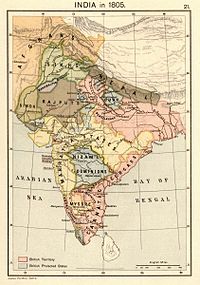
The Sikh Empire spanned a total of over 200,000 sq mi (520,000 km2) at its zenith.[51][52][53] Another more conservative estimate puts its total surface area during its zenith at 100,436 sq mi (260,124 km sq).[54]
The following modern-day political divisions made up the historical Sikh Empire:
- Punjab region, to Mithankot in the south
- Punjab, Pakistan, excluding Bahawalpur State
- Punjab, India, excluding the Cis-Sutlej states[55]
- Himachal Pradesh, India, only the territories northwest of Sutlej river.
- Jammu Division, Jammu and Kashmir, India and Pakistan (1808–1846)
- Kashmir, from 5 July 1819 to 15 March 1846, India/Pakistan[56][57]
- Kashmir Valley, India from 1819 to 1846
- Baltistan, from 1840 onwards[37][38][39]
- Gilgit, Gilgit–Baltistan, Pakistan, from 1842 to 1846[citation needed]
- Ladakh, India 1834–1846[58][59][36]
- Lower part of Khyber Pakhtunkhwa, Pakistan.[60]
- Peshawar, Pakistan[61] (taken in 1818, retaken in 1834)
- Excluding Waziristan, Ranjit Singh made no attempt to conquer Waziristan.[62][63]
Jamrud District (Khyber Agency, Pakistan) was the westernmost limit of the Sikh Empire. The westward expansion was stopped in the Battle of Jamrud, in which the Afghans managed to kill the prominent Sikh general Hari Singh Nalwa in an offensive, though the Sikhs successfully held their position at their Jamrud fort. Ranjit Singh sent his General Sirdar Bahadur Gulab Singh Powind thereafter as reinforcement and he crushed the Pashtun rebellion harshly.[64] In 1838, Ranjit Singh with his troops marched into Kabul to take part in the victory parade along with the British after restoring Shah Shoja to the Afghan throne at Kabul.[65]
Administrative divisions
This section needs expansion with: Please add the governors, capitals, borders, major cities, etc. for the various provinces of the Sikh Empire (with sources). You can help by adding to it. (March 2023) |

The empire was divided into various provinces (known as Subas), them namely being:[54]


